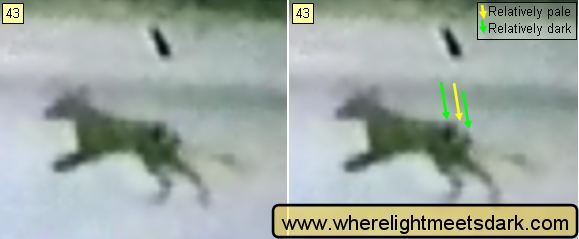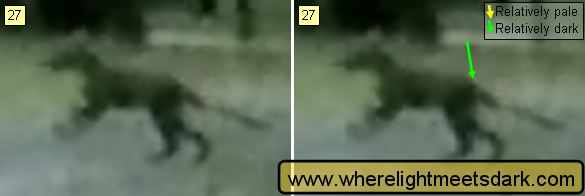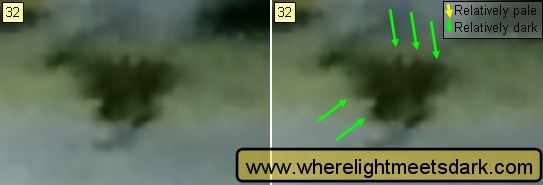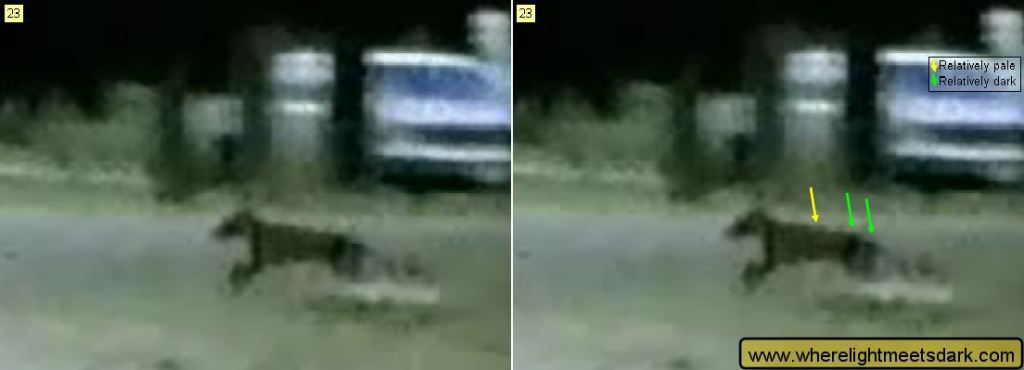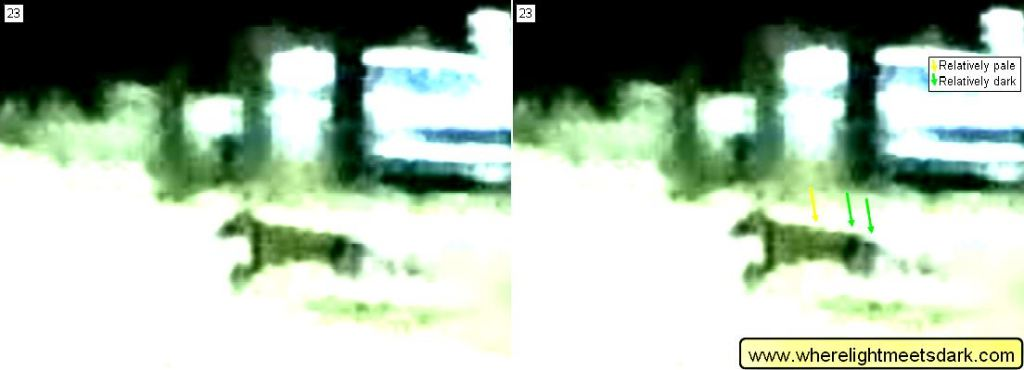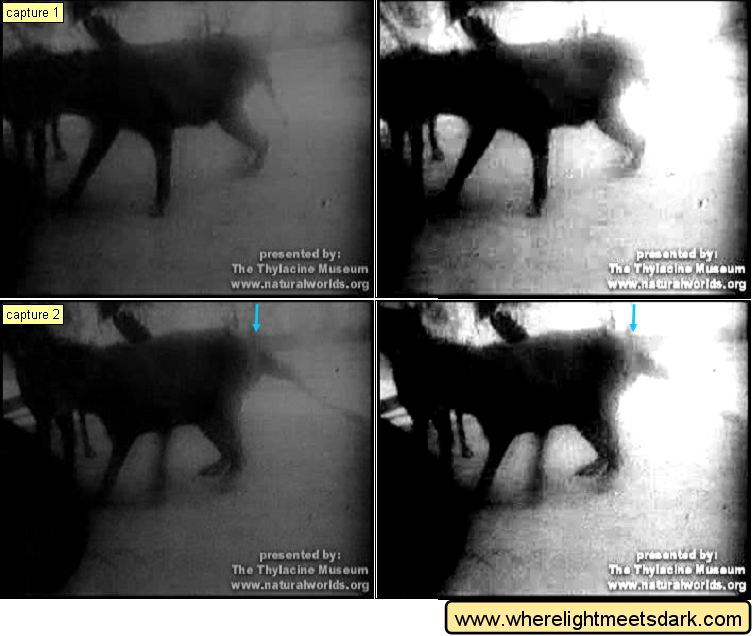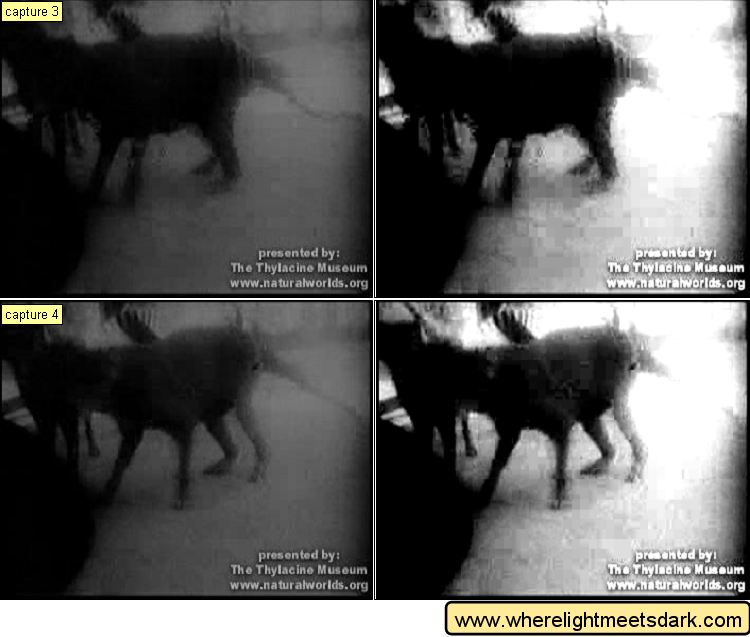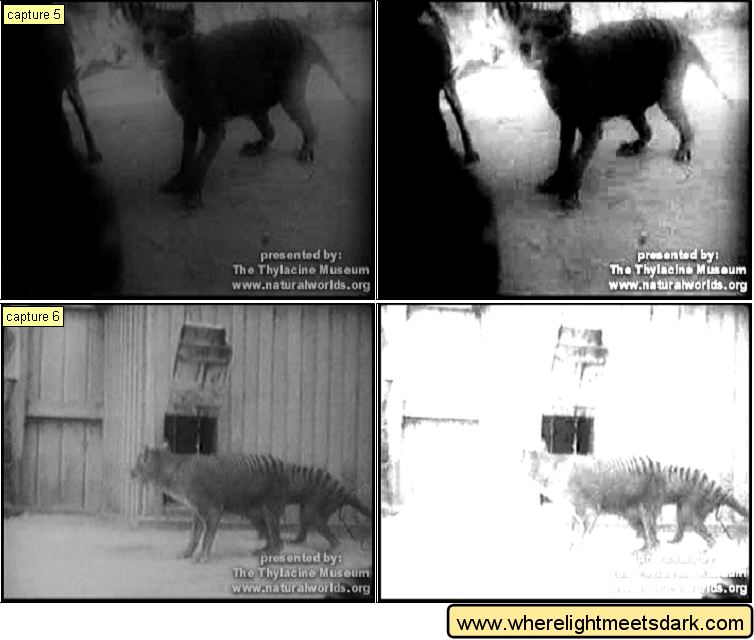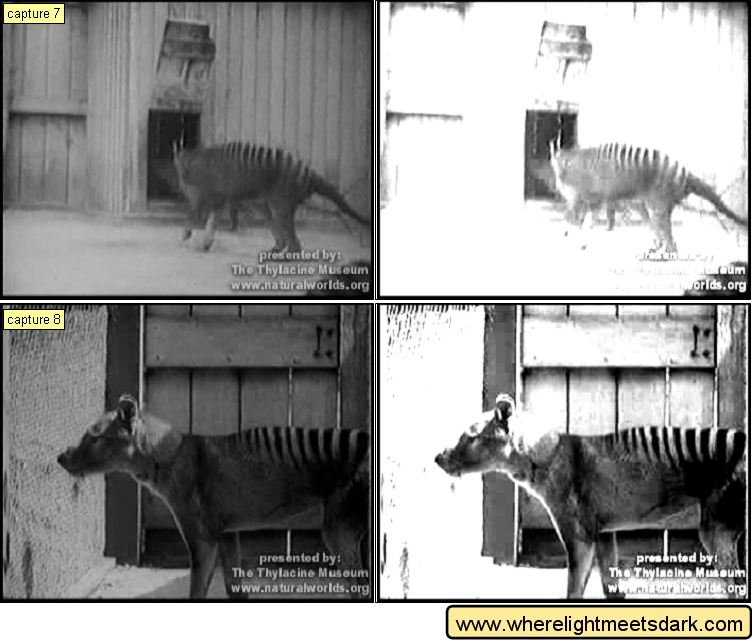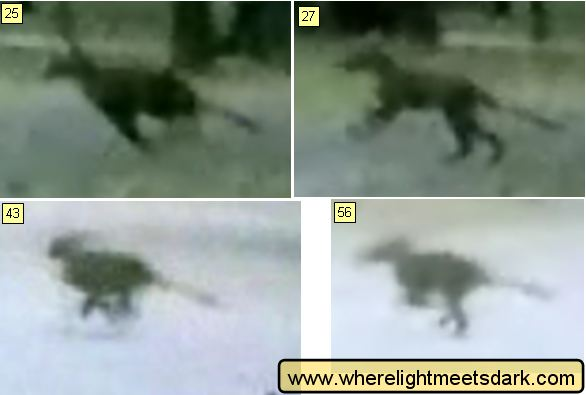Doyle thylacine - high resolution analysis
Overview
This article is the second in a series analysing the Doyle thylacine footage.
High resolution footage
As mentioned earlier in the Where Light Meets Dark discussion forum regarding the 1973 Doyle footage, I found a second copy of the footage which is higher resolution than that which I used in my first analysis of the 1973 Doyle footage.
The high resolution footage can be downloaded at El Tigre de Tasmania - Thylacinus Cynocephalus - I found Media Player (Win XP) wouldn't open it directly; I had to save the file then use another player. (Direct link to the video).
Many thanks to thylacine.1979.ws for making the clip available. In addition to being higher resolution, the image has been stabilized so that the animal remains vertically aligned, and it has been slowed down to make observation easier.
The MPEG file format
If you haven't read my original analysis, please be aware that the MPEG file format was never intended to produce still-frames. The compression technique used by the format means that a full frame is stored only periodically - the intervening frames are rendered by over-writing only some parts of the last rendering of the image. Then, after several such "partial but overlapping" renderings, another full frame is rendered.
This has serious implications for any frame analysis of the footage. To date, I have no knowledge of the present wherabouts of the original film, however.
Still frames
Once again, I paused the footage for every frame and captured as many as was possible. This yielded 63 images.
The previous analysis spent considerable time evaluating such features as the shape and positioning of the animal's tail, legs, ears and similar features. The intent of this present analysis is not to reproduce that work, but rather, to see whether the higher resolution data gives any insight into whether or not the animal displays stripes.
Frames showing stripes?
The first logical step was to identify which frames appear to display anything which might be construed as a stripe pattern. Quite clearly, the resolution is still not high enough to show without doubt whether the animal is striped, but my reasoning here is that if the animal was striped, then surely that alternation in contrast would have rendered at least some data in some frames.
Please do note that is an assumption.
In order to qualify as "possibly showing striping", the dorsal surface (the back of the animal) was examined in every frame. The back had to show at least one area of colouration that was obviously in contrast to the surrounding area - it could be lighter or darker.
In two frames, the rump of the animal is obscured by a tree in the foreground, so of the remaining 61 frames, 26 were selected as showing areas of unusual contrast along the animal's back. That is an astonishing 43 percent!
Could the animal have unusual fur colouration causing these observations? Or is there a viable alternative explanation?
Highest contrast markings
In my opinion, frame 43 is the one in which the colouration appears in highest contrast.
Lowest contrast markings
With just a single black spot, frame 27 is probably the one which shows the least contrast in an area of colouration variance which was selected for inclusion in my count.
Alternative explanations?
Could these markings have been caused by something other than the animal's colouration? Certainly!
It became obvious even whilst capturing the frames, that many visual artefacts appear on the film.
The first kind of artefact sees itself appear for a single - or very few - frames, and then it disappears again. An example of this can be seen in frame 43 (the high contrast frame), above - where a large black mark appeared above the animal for a single frame.
These artefacts are most likely explained as originating with the source film. Although I have not spent the time to research such behaviour, I think most readers will agree they are familiar with such specks appearing on amateur film footage shot in the 1970s.
Such artefacts may account for a very small number of the selected frames - it would be quite extraordinary for them to appear exactly on the animal's back in over 40 percent of the captured frames!
The second kind of artefact is probably not so much an artefact, but a limitation of the resolution of the footage.
Obvious distortions
Frame 14 best exhibits this second kind of "artefact" - at numerous points the head appears to exhibit unusual bumps. The appearance of this region is clearly replicated at other points along the back and at the rump. Quite clearly the animal is highly unlikely to have a bumpy head - nor a head exhibiting strong colour variation - as the vast majority of frames do not show anything like this at all.
Obvious distortion, second example
Frame 32 shows similar distortion, this time at the chest and forepaw of the animal.
Ignoring for a moment, the cause of these "artefacts", their appearance has serious implications for interpreting the high contrast areas elsewhere on the animal. If we accept that such large areas of high contrast colouration cannot be due to the animal's appearance itself in areas such as the head and chest, then we have to accept that all such areas of contrast - no matter where on the body - can be explained by image distortion.
Distortion in background
If we stop for a moment, and zoom out - recalling that we're not just examining the animal itself, but its whole context - you can see that similar distortion occurs in large portions of the background of frame 23. I selected this frame singly, whilst capturing the frames, to demonstrate this behaviour because even at that time the implications of this distortion became vastly obvious.
But we are left with a question - how come these areas of high colouration contrast seem to consistently occur on the back of the animal? Despite the background distortion, couldn't the areas of contrast observed on the animal still be due to its own colouration?
A theory for distortions in the video
In answering those questions, we perhaps come up with a theory for how these distortions appear in the images. Notice that in frame 23 there are also vast areas which appear to show minimal distortion - namely, the road in front of the animal.
Recall too, that the animated sequence involved the camera panning from right to left as it tracked the animal. The high-resolution version used for this analysis stabilised the image, but there was considerable vertical variance in camera angle also. Finally, bear in mind that the MPEG format only refreshes the full frame periodically. The PixelTools website summarises this excellently:
"Two adjacent frames in a motion picture sequence are usually very nearly identical. Often the only difference is that some parts of the picture have shifted slightly between the frames. MPEG compression exploits this temporal redundancy by carving each new frame into convenient pieces and searching the previous frame to determine where each piece came from. If the content of the current frame was mostly sent in the previous frame, why send it all again? Just send the instructions for shifting pieces of the previous frame to their new positions in the current frame."
In other words, in a vast majority of the frame captures, the presented image is actually like a mosaic of tiles which have been shuffled around slightly since the previous frame. Then periodically, an entire frame is rendered. On those areas of the frame where there is a lot of movement, the tile pieces are very small. This would include the animal itself in our analysis. On areas of the frame which do not exhibit much (apparent) movement - like the roadway - the tile pieces can be larger. For an example of the latter, also see the roadway behind the animal (above the WLMD logo).
Testing the theory
It would seem there is no real way to prove whether the high contrast frames are really due to the MPEG compression format, or to the animal itself. If the animal has only minimal striping, and given the low resolution of the footage (even in this high-res analysis), it is conceivable that many of the frames render without showing any apparent striping at all (which in this case would be the other 35 frames.
Still - for the next part of the analysis I adjusted the contrast levels of some of the frames. The aim behind this manual adjustment of the images was to emphasise the areas of contrast - to "wash out" the paler areas, and "darken" the darker areas.
In all cases I made the same adjustments: Using Microsoft Photo Editor 3.0.2.3 on Windows XP I adjusted the image balance (Image menu, Balance option). The brightness (for all colours) was adjusted from a value of 50 to 80 (out of a possible 100), and the contrast (for all colours) was adjusted from a value of 50 to 80 (out of a possible 100). No further manipulation was employed.
High contrast, frame 23
Begining with this same frame, a striking observation is made - in addition to the dark colouration apparent on the animal's rump, a near-vertical band is emphasised, running from the animal's neck down its shoulder and chest onto the forepaw. The face also exhibits an obviously darker region, but the near-vertical stripe is a most unusual observation - regardless of the kind of animal this might be.
High contrast, frame 22
Examining the two frames prior to frame 23 produces equally interesting results. Frame 22 also exhibits the near-vertical band. However, the main portion of the body is "cleaner" and "less blotchy" than frame 23. Knowing more now about how MPEG videos render, this lends weight to the idea that the "blotchiness" in frame 23 is produced by the design of the MPEG format. Whilst we can't know for sure that frame 23 is not a full-frame re-render, the appearance of the near-vertical stripe in both frames would seem to imply that neither are full-frame re-renders.
High contrast, frame 21
The lack of this near-vertical band in frame 21 (immediately preceding these two) lends even more weight.
High contrast, frame 14
By way of comparison, here is frame 14 - which was shown earlier. Although not apparent in the unadjusted image, the rib cage and neck both show obvious areas of darker colouration - even more than any of the areas identified on first inspection (indicated by arrows).
Comparison with reference thylacine footage
Before we come to our conclusions, let's take a moment to carry out a similar investigation using known thylacine footage. The film frame captures presented here were taken from the MPEG formats presented at the online Thylacine Museum.
Film captures 1 and 2
These are just about the poorest quality images I could obtain from the known thylacine footage. Even though they are not great, the animal occupies far more of the frame than in the Doyle footage (which means there is more detail available), and the animal is walking - not running. It goes without saying that the footage is also black and white - not colour.
In capture 2, the animal's stripes are just barely visible at the point indicated by the arrows. Notice that with the emphasised contrast, even this slight hint at the stripes is accentuated.
Film captures 3 and 4
In capture 3 the same effect can be observed - the stripes are barely visible in the original frame, and become accentuated with the emphasised contrast.
Film captures 5 and 6
Once again, capture 5 demonstrates the same effect. Capture 6 shows two thylacines. Interestingly, the fur around the neck "washed" right out with the increased contrast.
Film captures 7 and 8
Captures 7 and 8 really show how the stripes are actually emphasised by the process which was employed to adjust contrast - again, bearing in mind the differences between the films.
Capture 8 shows this magnificent animal in a beautiful profile. Note that a near-vertical band appears from the shoulder down to the rib cage - just a little behind the location where the MPEG artefact was observed.
Conclusion
All things considered, I believe it is most likely that the apparent "stripes" observed in the 1973 Doyle footage are the result of artefacts introduced by the MPEG delivery format.
At this stage it would be incredibly fantastic news if anyone were able to announce the present location of the original film reel. Via personal communications I am led to understand that the MPEG formats we currently have available were produced from a VHS recording of a television broadcast. Taking all these data conversions into account, I have no doubt that the original film would contain more - and crucial - information which might assist in more definitively asserting whether or not this animal has stripes.
However, in consideration of the above observations I believe the evidence as presented is not strong enough to conclude that the animal has stripes.
Clearly the limitations of the technologies allow for the possibility that the animal may yet be striped, but with the data available I cannot conclude that.
Final note - that tail
In closing, I present frames 25, 27, 43 and 56 - all of which show that remarkably stiff, thin and long tail which in my earlier analysis I counted as one of the most intriguing, and thylacine-like features of this animal.
Revisions
This article was first published at www.wherelightmeetsdark.com in 2006.
This article was migrated to www.wherelightmeetsdark.com.au in July 2017. This migration included:
- Rename article
- Add Overview
- Reformat text
- New section headings and reworded section headings
